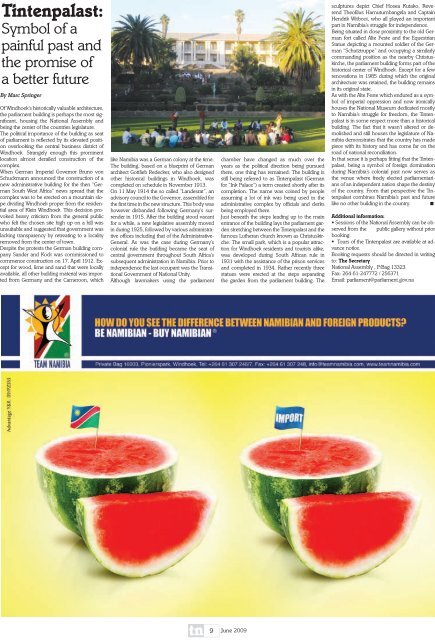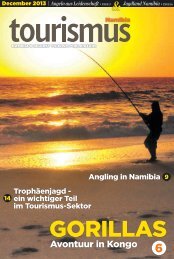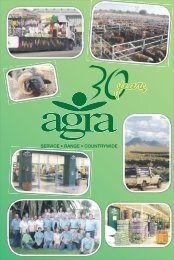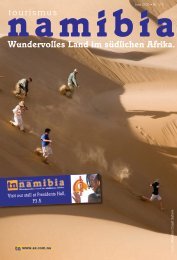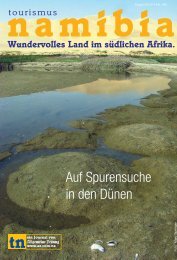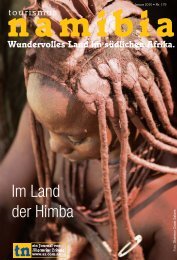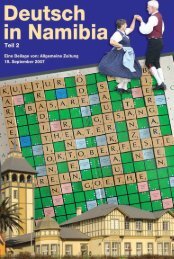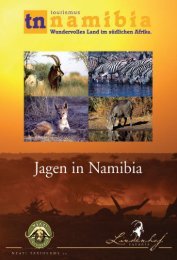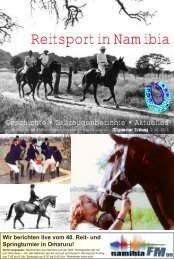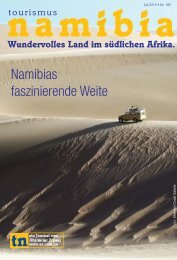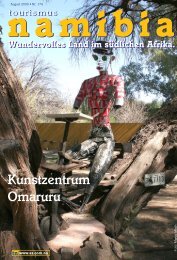Lesen - Allgemeine Zeitung
Lesen - Allgemeine Zeitung
Lesen - Allgemeine Zeitung
Create successful ePaper yourself
Turn your PDF publications into a flip-book with our unique Google optimized e-Paper software.
Tintenpalast:<br />
Symbol of a<br />
painful past and<br />
the promise of<br />
a better future<br />
By Marc Springer<br />
Of Windhoek’s historically valuable architecture,<br />
the parliament building is perhaps the most significant,<br />
housing the National Assembly and<br />
being the center of the countries legislature.<br />
The political importance of the building as seat<br />
of parliament is reflected by its elevated position<br />
overlooking the central business district of<br />
Windhoek. Strangely enough this prominent<br />
location almost derailed construction of the<br />
complex.<br />
When German Imperial Governor Bruno von<br />
Schuckmann announced the construction of a<br />
new administrative building for the then “German<br />
South West Africa” news spread that the<br />
complex was to be erected on a mountain slope<br />
dividing Windhoek proper from the residential<br />
area of Klein Windhoek. This decision provoked<br />
heavy criticism from the general public<br />
who felt the chosen site high up on a hill was<br />
unsuitable and suggested that government was<br />
lacking transparency by retreating to a locality<br />
removed from the center of town.<br />
Despite the protests the German building company<br />
Sander and Kock was commissioned to<br />
commence construction on 17. April 1912. Except<br />
for wood, lime and sand that were locally<br />
available, all other building material was imported<br />
from Germany and the Cameroon, which<br />
like Namibia was a German colony at the time.<br />
The building, based on a blueprint of German<br />
architect Gottlieb Redecker, who also designed<br />
other historical buildings in Windhoek, was<br />
completed on schedule in November 1913.<br />
On 11 May 1914 the so called “Landesrat”, an<br />
advisory council to the Governor, assembled for<br />
the first time in the new structure. This body was<br />
however disbanded following Germany’s surrender<br />
in 1915. After the building stood vacant<br />
for a while, a new legislative assembly moved<br />
in during 1925, followed by various administrative<br />
offices including that of the Administrative-<br />
General. As was the case during Germany’s<br />
colonial rule the building became the seat of<br />
central government throughout South Africa’s<br />
subsequent administration in Namibia. Prior to<br />
independence the last occupant was the Transitional<br />
Government of National Unity.<br />
Although lawmakers using the parliament<br />
chamber have changed as much over the<br />
years as the political direction being pursued<br />
there, one thing has remained: The building is<br />
still being referred to as Tintenpalast (German<br />
for “Ink Palace”) a term created shortly after its<br />
completion. The name was coined by people<br />
assuming a lot of ink was being used in the<br />
administrative complex by officials and clerks<br />
being employed there.<br />
Just beneath the steps leading up to the main<br />
entrance of the building lays the parliament garden<br />
stretching between the Tintenpalast and the<br />
famous Lutheran church known as Christuskirche.<br />
The small park, which is a popular attraction<br />
for Windhoek residents and tourists alike,<br />
was developed during South African rule in<br />
1931 with the assistance of the prison services<br />
and completed in 1934. Rather recently three<br />
statues were erected at the steps separating<br />
the garden from the parliament building. The<br />
9 June 2009<br />
sculptures depict Chief Hosea Kutako, Reverend<br />
Theofilus Hamutumbangela and Captain<br />
Hendrik Witbooi, who all played an important<br />
part in Namibia’s struggle for independence.<br />
Being situated in close proximity to the old German<br />
fort called Alte Feste and the Equestrian<br />
Statue depicting a mounted soldier of the German<br />
“Schutztruppe” and occupying a similarly<br />
commanding position as the nearby Christuskirche,<br />
the parliament building forms part of the<br />
historical center of Windhoek. Except for a few<br />
renovations in 1985 during which the original<br />
architecture was retained, the building remains<br />
in its original state.<br />
As with the Alte Feste which endured as a symbol<br />
of imperial oppression and now ironically<br />
houses the National Museum dedicated mostly<br />
to Namibia’s struggle for freedom, the Tintenpalast<br />
is in some respect more than a historical<br />
building. The fact that it wasn’t altered or demolished<br />
and still houses the legislature of Namibia<br />
demonstrates that the country has made<br />
piece with its history and has come far on the<br />
road of national reconciliation.<br />
In that sense it is perhaps fitting that the Tintenpalast,<br />
being a symbol of foreign domination<br />
during Namibia’s colonial past now serves as<br />
the venue where freely elected parliamentarians<br />
of an independent nation shape the destiny<br />
of the country. From that perspective the Tintenpalast<br />
combines Namibia’s past and future<br />
like no other building in the country. n<br />
Additional information:<br />
• Sessions of the National Assembly can be observed<br />
from the public gallery without prior<br />
booking.<br />
• Tours of the Tintenpalast are available at advance<br />
notice.<br />
Booking requests should be directed in writing<br />
to: The Secretary<br />
National Assembly , P/Bag 13323<br />
Fax: 264-61-247772 / 256371<br />
Email: parliament@parliament.gov.na


